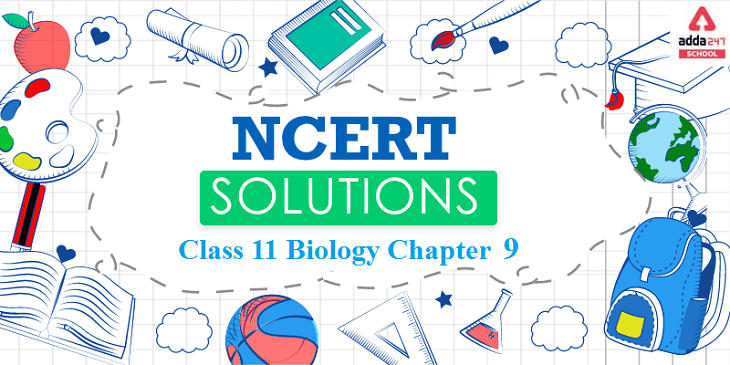Table of Contents
Class 11 biology chapter 9 Ncert solutions In English
Class 11 biology chapter 9 Ncert Solutions: Adda 247 provides NCERT Solutions for Class 11 Biology Chapter 9 which is for the students who want to go ahead in life and achieve great marks in their examinations. The NCERT Solutions for class 11 are provided by the teachers who are experts of their subjects. The solutions are set according to the rules formulated by the NCERT class 11 biology and in the language that can be understood by every student. By these reading the solutions students can build up a strong base easily. The NCERT class 11 Biology solutions covers the chapters 1 to 22 with the important questions and the answers in a detailed way.
Examinations can be threatening for some people, a proper learning of the concepts is the key to crack the examination. Students rely on the solutions of the NCERT provided by Adda 247. The solutions are formulated by the experts of the subjects who have tremendous knowledge in their subjects.
These NCERT Solutions of class 11 help the students to get familiarized with the textbooks. The students can access the solutions anywhere while browsing the web easily. The solutions are very precise and accurate.
NCERT Solutions for Class 11 Biology Chapter 9 – Biomolecules
The chapter provides information about Biomolecules. Biomolecules are the molecules or ions present in an organism that are essential for the biological processes such as growth, development, cell division, etc. Biomolecules include large molecules or macromolecules such as proteins, carbohydrates, lipids, and nucleic acids, whereas the smaller molecules or macromolecules include metabolites and natural products.
Click Here! To Download Free PDF of Ncert Solutions for Class 11 Biology Chapter 9
Features of the NCERT Solution Class 11 Biology Chapter 9- Biomolecules
NCERT Solutions of class 11 have been answered based on the important information on the question.
- The columns are used wherever necessary.
- Solutions are solved point-wise and accurately answered point to point.
Important Questions of Ncert Solutions Class 11 Biology Chapter 9
Question 1. What are macromolecules? Give examples.
Answer: Macromolecules are large, high molecular weight substances with complex molecular structure and occur in colloidal state (being insoluble) in intracellular fluid. They are formed by polymerisation of large number or micromolecules. Examples are polysaccharides, proteins and nucleic acids.
Question 3. What is meant by tertiary structure of proteins?
Answer: Tertiary structure is the next level of complexity in protein folding. Tertiary structure is the three-dimensional structure of a protein. While individual amino acids in the primary sequence can interact with one another to form secondary structures such as helices and sheets and individual amino acids from distant parts of the primary sequence can intermingle via charge-charge, hydrophobic, disulfide, or other interactions, the formation of these bonds and interactions will serve to change the shape of the overall protein.
Question 5. Proteins have primary structure. If you are given a method to know which amino acid is at either of the two termini (ends) of a protein, can you connect this information to purity or homogeneity of a protein?
Answer: Yes, if we are given a method to know the sequence of proteins, we can use this information to determine purity of a protein. It is known that an accurate sequence of a certain amino acid is very important for the functioning of a protein. If there is any change in the sequence, it would alter its structure, thereby altering the function. So by knowing sequence of a given protein, we can determine its structure and compare it with any of the known correct protein sequence. Any change in the sequence can be linked to the purity or homogeneity of a protein.
For example, a single change in the sequence of haemoglobin in P chain at 6th position can alter the normal haemoglobin structure to an abnormal structure that can cause sickle cell anaemia.
Question6. Find out and make a list of proteins used as therapeutic agents. Find other applications of proteins (e.g., Cosmetics etc.).
Answer: Proteins are used as therapeutic agents because:
(i) Thrombin and fibrinogen- They help in blood clotting.
(ii) Insulin- It is used in diabetes as it helps in maintaining blood glucose level in the body. (iii) Renin- It helps in osmoregulation.
(iv) Lactoferrin- It is used as an antimicrobial.
(v) Trypsin- It is used in pharmaceutical.
Question 7. Explain the composition of triglyceride.
Answer:
(1) The components of triglyceride are single molecule of glycerol and 3 fatty acids.
(2) In glycerol 3 carbon atoms are present along with 30 n groups.
(3) Fatty adds consist of a long chain hydrocarbon with a carboxylic group at one end.
(4) Both of them form ester bond. This bond is saturated when single bonded carbons are present and
unsaturated when double bonded carbon atom (—c = c—) are present.
Question 8. Can you describe what happens when milk is converted into curd or yoghurt, from your understanding of proteins.
Answer: Milk contains a protein called casein. This protein gives milk its characteristic white colour. It is of high nutritional value because it contains all the essential amino acids required by man’s body. The curd forms because of the chemical reaction between lactic acid bacteria and casein. When curd is added to milk, the lactic acid bacteria present in it cause coagulation of casein and thus, convert it into curd.
Question 9. Can you attempt building models of biomolecules using commercially available atomic models (Ball and Stick models).
Answer: Ball and stick models are 3-D molecular models that can be used to describe the structure of biomolecules. In ball and stick model, the atoms are represented as balls where the bonds that hold the atoms are represented by the sticks. Double and triple bonds are represented by springs that form curved connection between the balls. The size and colour of various atoms are different and are depicted by the relative size of the balls.
Question 10. Attempt titrating an amino acid against a weak base and discover the number of dissociating (ionizable) functional groups in the amino acid.
Answer: Titrating a neutral or basic amino acid against a weak base will dissociate only one functional group, whereas titration between acidic amino acid and a weak base will dissociate two or more functional groups.
Question 12. What are gums made of? Is Fevicol different?
Answer: Natural gum is a polysaccharide of natural origin. It has high viscosity even at low concentration. Fevicol is a synthetic glue. Synthetic glue is usually made of polymers which are dissolved in a solvent. When the adhesive is exposed, the solvent evaporates; resulting in hardening of the adhesive. Synthetic adhesives come in various strengths and are used accordingly.
Question 14. Find out how much cellulose is made by all the plants in the biosphere and compare it with how much of paper is manufactured by man and hence what is the consumption of plant material by man annually. What a loss of vegetation!
Answer: Around 85 billion tonnes of cellulose is formed annually in the biosphere (out of 170 billion tonnes of total organic matter). Paper making consumes roughly 0.5 billion tonnes of wood, food grains comprise 1.5 billion tonnes. Full wood required 2 billion tonnes. The increase in consumption of cellulose has resulted in great loss of vegetation.


 ISC Class 12 Business Studies Question P...
ISC Class 12 Business Studies Question P...
 ICSE Class 10 Maths Answer Key 2025 Out,...
ICSE Class 10 Maths Answer Key 2025 Out,...
 CBSE Class 12 Maths Question Paper 2025,...
CBSE Class 12 Maths Question Paper 2025,...







